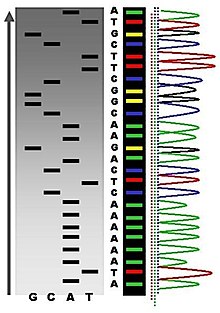Molecular biology and molecular genetics are closely related fields of study that focus on the structure, function, and behavior of molecules within living organisms. Molecular biology is a broad field that encompasses many different sub-disciplines, including molecular genetics. Molecular genetics is a sub-discipline of molecular biology that focuses specifically on the role of genes and how they are expressed and inherited within living organisms. In other words, molecular genetics is a more specialized field within molecular biology that focuses on the genetic makeup of cells and how genes are passed down from one generation to the next.
वर्ग DNA
Central Dogma of Biology
 |
| Picture source: Wikimedia |
The central dogma of molecular biology is a term coined by Francis Crick to describe the flow of genetic information in living organisms. This flow of information is essential for the functioning of all cells, and is the basis for many of the fundamental processes of life, such as growth, development, and reproduction.
The central dogma of molecular biology states that genetic information flows from DNA to RNA to protein. This process begins with the transcription of DNA into RNA, which is carried out by enzymes called RNA polymerases. RNA polymerases bind to specific sequences in the DNA called promoters, and then use the DNA as a template to synthesize an RNA molecule that is complementary to the DNA.
This RNA molecule, also known as messenger RNA (mRNA), is then used as a template for the synthesis of a protein molecule. This process, known as translation, is carried out by ribosomes, which are cellular structures that are responsible for protein synthesis. The ribosome reads the sequence of nucleotides in the mRNA, and uses this information to synthesize a protein molecule with a specific sequence of amino acids.
The flow of genetic information from DNA to RNA to protein is essential for the functioning of all cells. DNA contains the genetic information that is required for the synthesis of all of the proteins that are necessary for life. The process of transcription and translation allows cells to produce the proteins that they need in order to carry out their functions.
The central dogma of molecular biology has been supported by a wealth of experimental evidence, and it is considered to be one of the fundamental principles of molecular biology. It has also been extended and refined over time to include additional details about the process of gene expression, such as the role of regulatory elements and the mechanisms by which genes are turned on and off.
In addition to its importance in molecular biology, the central dogma has also had a significant impact on other fields of science, such as medicine and biotechnology. For example, the ability to manipulate the flow of genetic information has led to the development of powerful new tools for studying and treating genetic diseases, as well as for producing valuable proteins and other biomolecules for use in research and industry.
The central dogma of molecular biology is a key concept that helps to explain how genetic information is used and transmitted in living organisms. It is a fundamental principle that has had a profound impact on our understanding of the basic processes of life, and continues to be an important area of research in the field of molecular biology.
What are common molecular biology techniques
 |
| Sanger sequencing |
Molecular biology deals with the structure and function of macromolecules, such as nucleic acids and proteins, which are essential to life. Molecular biology techniques are a set of tools and methods used by scientists to study and manipulate the structure and function of these macromolecules. Some common molecular biology techniques including:
- Polymerase chain reaction (PCR): This is a technique used to amplify a specific DNA sequence in order to make large amounts of a particular DNA fragment for further analysis. This is done by using special enzymes called polymerases to synthesize new strands of DNA complementary to the target sequence.
- Gel electrophoresis: This is a technique used to separate DNA or protein molecules based on their size and charge. A sample of DNA or protein is placed in a gel matrix, and an electric current is applied to the gel. The molecules migrate through the gel, and the smaller molecules move faster than, the larger ones, allowing them to be separated into distinct bands.
- DNA sequencing: This is a technique used to determine the order of the nucleotides in a DNA molecule. This is done by using special enzymes to break the DNA molecule into smaller fragments and then using dideoxynucleotides, which are nucleotides that can terminate DNA synthesis, to create a series of DNA fragments of known length. These fragments are then separated by gel electrophoresis, and the order of the nucleotides is determined by comparing the sequences of the fragments.
- Western blotting: This is a technique used to detect specific proteins in a sample. The sample is first separated by gel electrophoresis, and then the proteins are transferred from the gel to a membrane. The membrane is then incubated with antibodies that specifically bind to the target protein, and the presence of the protein is detected using a special detection method.
- Cloning: This is a technique used to create multiple copies of a specific DNA sequence. This is done by inserting the DNA sequence into a vector, such as a plasmid, which is then introduced into a host cell, such as a bacterial cell. The host cell replicates the vector and the inserted DNA sequence, producing multiple copies of the DNA.
These are just a few examples of the many molecular biology techniques that are used in research. These techniques have greatly advanced our understanding of the structure and function of macromolecules and have contributed to many important discoveries and advances in the fields of biology and medicine.
How does qPCR work?
Quantitative polymerase chain reaction (qPCR) is a molecular biology technique that is used to amplify and measure the amount of a specific DNA or RNA sequence in a sample. It is a highly sensitive and specific method that can be used to detect and quantify the amount of a specific sequence in a sample, even when it is present at very low levels.
| Picture source: Wikimedia |
qPCR is based on the same principles as PCR (polymerase chain reaction), but it includes additional steps that allow for the quantitative measurement of the amplified DNA or RNA. In qPCR, a sample of DNA or RNA is first amplified using PCR. During the amplification process, specific fluorescent dyes or probes are added to the reaction mixture, which bind to the amplified DNA or RNA. As the amplification proceeds, the amount of fluorescent signal produced increases in proportion to the amount of amplified DNA or RNA.
After the amplification is complete, the qPCR machine measures the amount of fluorescence produced during the reaction. This allows the researcher to determine the amount of the specific DNA or RNA sequence present in the sample. Because the amount of fluorescence produced is directly proportional to the amount of amplified DNA or RNA, qPCR can be used to accurately measure the amount of a specific sequence in a sample, even when it is present at very low levels.
qPCR is an important molecular biology technique that allows researchers to quickly and accurately measure the amount of a specific DNA or RNA sequence in a sample, providing valuable insights into the molecular mechanisms of diseases and other biological processes.

